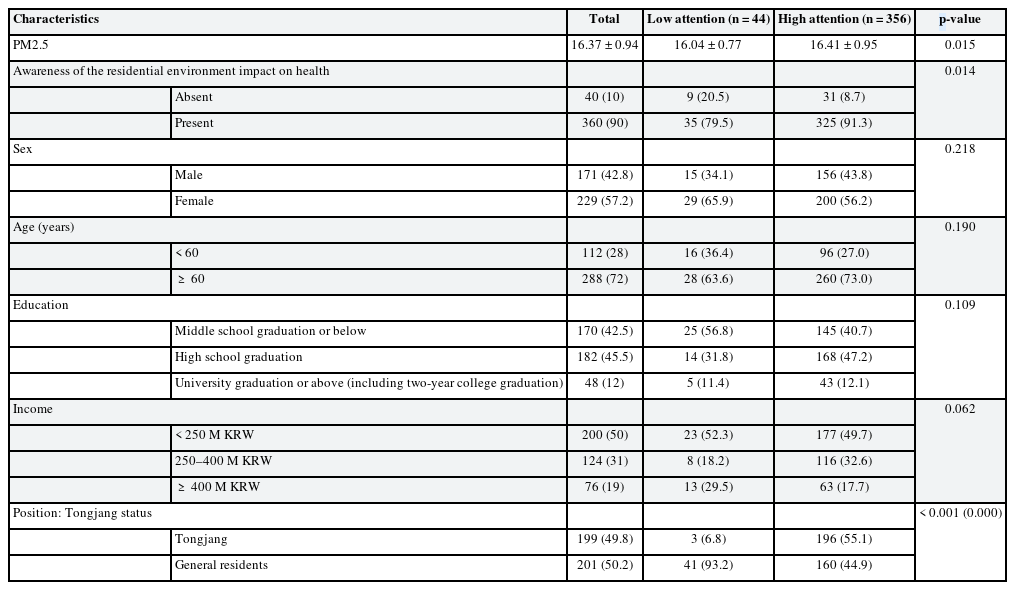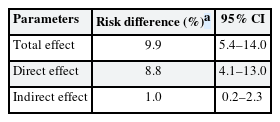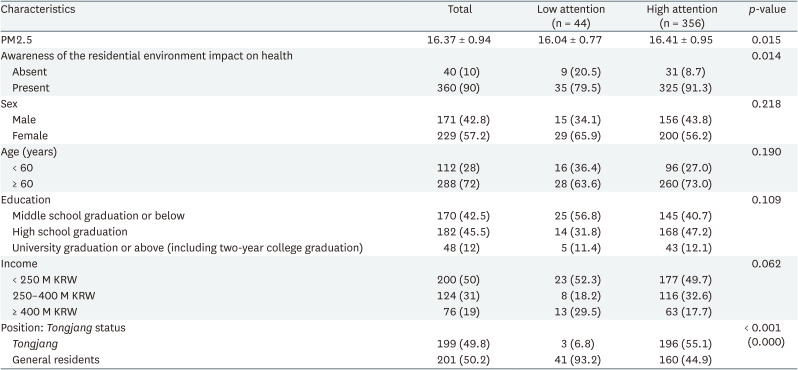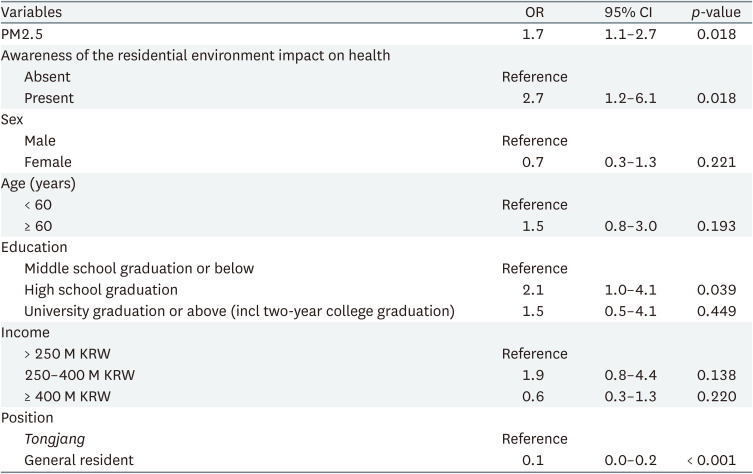Particulate matter concentration effects on attention to environmental issues: a cross-sectional study among residents in Korea’s Pohang Industrial Complex
Article information
Abstract
Background
With modernization, air pollution has become increasingly serious, and its effects on health have been revealed. As a result, public interest in environmental pollution has become critical for regulating air pollution. In our study, we aim to evaluate the impact of air pollution levels on public attention to environmental issues and examine whether awareness of the residential environment’s impact on health acts as a mediator in this relationship.
Methods
We conducted an analysis on 400 individuals surveyed in the preliminary feasibility study on adverse health effects in the Pohang Industrial Complex, to examine the relationship between particulate matter 2.5 (PM2.5) and attention to environmental issues. Logistic regression analysis was performed, and mediation analysis was used to determine whether awareness of the residential environment’s impact on health mediated the relationship.
Results
The logistic regression analysis results showed that PM2.5 levels were associated with attention to environmental issues (adjusted odds ratio [AOR]: 2.1; 95% confidence interval [CI]: 1.3–3.5; p = 0.003) and awareness of health impacts (AOR: 3.4; 95% CI: 1.6–7.1; p = 0.001). The PM2.5 levels showed 9.9% (95% CI: 5.4–14.0) increase in the prevalence of high attention to environmental issues, of which, only 1.0% (95% CI: 0.2–2.3) were mediated by health impact awareness. In the overall analysis, 10% of the total effect of PM2.5 on attention to environmental issues was mediated by health impact awareness.
Conclusions
According to this study’s results, there was a correlation between air pollution levels and attention to environmental issues. Awareness of the health impacts of air pollution partially mediated the effect of air pollution levels on attention to environmental issues. In future studies, it is recommended to identify other mediators to further understand this structure.
INTRODUCTION
Although the world has made significant progress in urban development and growth, it has worsened in terms of air pollution, leading to growing interest and studies on the health effects of air pollution. According to these studies, air pollution is associated with cardio-cerebrovascular diseases, such as arrhythmia, heart failure, myocardial infarction, and ischemic stroke; respiratory diseases, such as asthma, lung function decline, and lung cancer; morbidity; and mortality.123456 Hence, controlling air pollution worldwide from a public health perspective is crucial to lowering the environmental burden of diseases.
Increased public awareness is essential for environmental issues, and inadequate attention may cause a lack of participation in air pollution regulations, diminishing the public’s influence on environmental issues and making it challenging to control air pollution through policies.7 This also affects individuals’ precautionary behavior, such as proactive defensive purchase and passive avoidance behavior, relating to personal exposure to the public and the environmental burden of disease.8 Therefore, attention to environmental pollution is crucial in controlling air pollution from policy and individual perspectives.
Several factors, including air pollution, have been recognized to affect the attention level to environmental issues. Previous research shows that higher air pollution levels are associated with greater attention to environmental pollution.791011 However, few studies have considered a potential structure affecting the attention level to the environmental problem. Inspecting the causal mechanisms provides a more in-depth understanding of the social and economic policy implications, which is more valuable than simply considering the total effect. This enables policymakers to make more effective decisions and optimize their policies. In this context, we hypothesized that increased public awareness regarding worsening air pollution would also raise awareness of its health effects, thereby increasing awareness of widespread environmental problems.
This study aimed to investigate the association between particulate matter 2.5 (PM2.5) concentration and attention to environmental issues and the potential mediating effect of the awareness of the residential environment’s impact on health using data from the risk-communication survey of residents in the Pohang Industrial Complex.
METHODS
Data sources
This study used the risk communication survey data in the preliminary feasibility study on adverse health effects in the Pohang Industrial Complex conducted by the National Institute of Environmental Research (NIER) in South Korea. The NIER promoted a three-phase project on “monitoring exposure to environmental pollutants and health effects on residents living around industrial complexes” from 2003 to 2022, intended to investigate the health effects associated with industrial complexes systematically. During this period, the “Act on Liability for Environmental Damage and Relief” was enacted in 2016, and relief from environmental pollution damages thus became possible upon evidence of the link between environmental pollution and health concerns. Accordingly, along with the three-phase project, a preliminary feasibility study was implemented to establish grounds for environmental damage remedies for residents near the Pohang Industrial Complex. The preliminary feasibility study included a risk communication survey targeting residents near the Pohang Industrial Complex to integrate various stakeholders’ opinions and build trust with the local community.
Study design, size, and participants
This cross-sectional study utilized data from the risk communication survey targeting nine regions in Pohang City where exposure to hazardous substances emitted from the Pohang Industrial Complex was expected to be high. The survey was initially conducted on 201 resident representatives from nine regions of Pohang City and then was subsequently performed on 201 general residents matched by gender and age. Of these, 400 residents were analyzed, excluding two who refused to respond on income level.
Measurements
Fine PM2.5 concentration
The PM2.5 concentration distribution was estimated by combining measurement-based and modeling-based concentration distribution maps. The measurement-based concentration distribution map was created using spatial interpolation methods based on data from eight air quality monitoring systems in Pohang City. The spatial interpolation methods included the inverse distance weighting method and ordinary kriging methods using spherical, exponential, and Gaussian models. The ordinary kriging method using a spherical model was finally employed due to the lowest prediction error. The modeling-based concentration distribution map was created using the CALPUFF modeling system, an atmospheric dispersion model developed by the United States Environmental Protection Agency, based on Clean Air Policy Support System emission data from 2013 to 2017 in Korea. The CALPUFF modeling system comprises three main components: CALMET, CALPUFF, and CALPOST. CALMET generates a three-dimensional (3D) wind and atmospheric field, and CALPUFF is a non-steady state Gaussian puff model that calculates the spatiotemporal changes of pollutants in a 3D wind field. CALPOST calculates the concentration in grid points and displays the distribution map.12
Based on the final concentration distribution map, the PM2.5 concentration was assigned to each administrative district dong, the smallest geographic information unit available in the National Health Insurance Service database.
Attention to environmental issues
The participants were asked the following survey question: “How much are you interested in environmental issues in your area?” Responses were rated on a four-point Likert scale (strongly, somewhat, a little, and hardly) and dichotomized into high (strongly and somewhat) versus low (a little and hardly).
Awareness of the residential environment’s impact on health
The participants were asked the following survey question: “Do you think your residential environment affects your health?” Responses were rated on a four-point Likert scale (strongly agree, slightly agree, slightly disagree, and strongly disagree) and dichotomized into yes (strongly agree and slightly agree) versus no (slightly disagree and strongly disagree).
Covariates
We reviewed the variables investigated in the survey and selected those that could act as potential confounders. These include gender, age (≥ 60 and < 60 years old), educational level (middle school or below, high school, and college or above), monthly household income level (< KRW 2.5 million, KRW 2.5–4 million, and ≥ KRW 4 million), and position (resident representatives and general residents).
Statistical analysis
The participants' descriptive characteristics were presented using means and standard deviations (SDs) for continuous variables and numbers and percentages for categorical variables. Differences in characteristics of participants according to attention to environmental issues were analyzed using the t-test and chi-square test. Simple and multiple logistic regression models were fitted to assess the association of PM2.5 concentration with attention to environmental issues and with awareness of the residential environment’s impact on health.
We used the medeff package in Stata (StataCorp, College Station, TX, USA) to evaluate the mediating effect of the awareness of the residential environment’s impact on health on the association between PM2.5 concentration and attention to environmental issues. The medeff package utilizes a simulation-based counterfactual approach to estimate direct, indirect, and total effects based on the quasi-Bayesian Monte Carlo approximation.13 Unlike other methods, this approach is not constrained by the rare outcome assumption and reports effect estimates as risk differences. Since counterfactuals are hypothetical outcomes that would be observed if the subject’s exposure had been determined to a specific value, two particular values must be set to estimate the causal effect if the exposure is a continuous variable. Therefore, we set the minimum and maximum integers within the range of observed PM2.5 concentration as exposure values. We defined the direct effect as the effect of PM2.5 concentration on attention to environmental issues not mediated through the awareness of the residential environment’s impact on health and indirect effect as the effect mediated through the awareness of the residential environment’s impact on health. Statistical significance was set at less than 0.05, and statistical analyses were performed using Stata version 17.0.
Ethics statement
This study’s protocol was reviewed and approved by the Institutional Review Board (IRB) of Ewha Womans University Mokdong Hospital (approval IRB No. EUMC 2021-09-032). Informed consent was submitted by all the participants when they were enrolled.
RESULTS
General characteristics of participants
Table 1 presents the descriptive characteristics of the study participants. Of the 400 respondents, 356 (89.0%) had high attention to environmental issues. The means and SDs of PM2.5 concentration for respondents with high and low attention to environmental issues were 16.41 ± 0.95 and 16.04 ± 0.77, respectively. More detailed information regarding the PM2.5 levels in each region is presented in Supplementary Table 1.
Respondents with low attention to environmental issues were less likely to think the residential environment affects their health (79.5% vs. 91.3%). The most significant difference in characteristics by attention to environmental issues was found in the context of the position: 44.9% of respondents with high attention to environmental issues and 93.2% of those with low attention to environmental issues were general residents.
Unadjusted associations between covariates and attention to environmental issues
Table 2 shows the results of simple logistic regression models examining the relationship between covariates and attention to environmental issues. We found that awareness of the residential environment’s impact on health, educational level of high school, and position of general residents were associated with 2.7-fold (95% confidence interval [CI]: 1.2–6.1), 2.1-fold (95% CI: 1.0–4.1), and 0.1-fold (95% CI: 0.0–0.2) increased odds of high attention to environmental issues, respectively.
Adjusted associations of PM2.5 with attention to environmental issues and with awareness of the residential environment’s impact on health
Table 3 shows the results of multiple logistic regression models examining the associations of PM2.5 concentration with attention to environmental issues and awareness of the residential environment’s impact on health. When all covariates were adjusted, a 1 μg/m3 increase in PM2.5 concentration was associated with 2.1-fold (95% CI: 1.3–3.5) and 3.4-fold (95% CI: 1.6–7.1) increased odds of high attention to environmental issues and awareness of the residential environment’s impact on health, respectively.
Mediating effect of the awareness of the residential environment’s impact on health on the association between PM2.5 and attention to environmental issues
Table 4 presents the direct, indirect, and total effects of PM2.5 on attention to environmental issues. An increase in PM2.5 from 16 µg/m3 to 18 µg/m3, representing the respective minimum and maximum integers within the range of PM2.5 in Pohang city, was associated with a 9.9% (95% CI: 5.4–14.0) increase in the prevalence of high attention to environmental issues. Among the total effect, the direct effect and indirect effects were 8.8% (95% CI: 4.1–13.0) and 1.0% (95% CI: 0.2–2.3), respectively, indicating that awareness of the residential environment’s impact on health mediates 10% of the total effect.
DISCUSSION
In this study, we found that an increase in PM2.5 concentration was associated with high attention to environmental issues, and approximately 10% of its impact was mediated through the awareness of the residential environment’s impact on health when assumed as a mediator.
Numerous studies exploring the relationship between PM2.5 concentration and attention to environmental issues have been primarily conducted in China and reported that high PM2.5 concentration was associated with increased attention to environmental issues. A correlation analysis study in China reported strong association between PM2.5 levels and public concern about smog as measured by the Baidu index.10 Additionally, a study in Shanghai, China, conducted by Dong et al.,9 revealed that actual air pollution levels increased residents' concerns about air pollution. This is consistent with findings from other studies, which observed that as air pollution levels rose, there was an increase in the number of messages and posts about air pollution through Chinese media.1114 These results support the notion that as air pollution levels increase, attention to environmental issues also increases.
Also, studies investigating the influence of air pollution on awareness of the residential environment’s impact on health have reported positive associations, although they used the perception of air pollution levels as a surrogate marker instead of actual air pollution levels.1516 This study found a significant relationship between actual PM2.5 concentration and the awareness of the health impact of the residential environment, aligning with the plausible explanations from previous studies. Existing evidence supports that actual air pollution levels affect the perception of air pollution levels.171819 Consequently, it can be inferred that the concentration of PM2.5 might influence awareness of the health impact in the residential environment by increasing the overall awareness of air pollution levels.
In this study, the mediating effect of the awareness of the residential environment’s impact on health was about 10% of the total effect, which fell short of our expectations. This might imply that other unmeasured mediating pathways exist between PM2.5 and attention to environmental issues. One potential mediator might be disease symptoms attributed to air pollution. Increased PM2.5 concentrations increase the incidence of allergic and respiratory symptoms and diseases.2021 Review article conducted in Malaysia have observed that the number of outpatients with respiratory diseases increased by 2–3 times during the period when the haze reached its maximum level. In addition, the number of patients with respiratory disease, asthma, and conjunctivitis increased by five times in September and October when haze was severe in various regions of Malaysia. Also in September, daily conjunctivitis incidences were associated with PM10 levels.22 With a notable rise in the number of individuals experiencing symptoms, there is a corresponding effort among individuals and their families to manage and prevent exacerbation of symptoms. Air pollution plays a significant role as an exacerbating factor in respiratory and allergic diseases.232425 Consequently, this increased focus on symptom management is likely to lead to heightened attention towards air pollution.
Another possible mediator could be the media, which plays an influential role as an information provider in society.26 Based on a Korean public opinion study conducted in the USA, it was found that Korean news reports on haze from China established a connection between the level of emphasis given by the media to certain topics and the level of public attention devoted to these issues.27 In the context of severe air pollution, heightened media coverage effectively addresses the challenge of limited public attention and refocuses it on the urgent matter of air pollution amidst numerous competing public concerns. As air pollution worsens, an expanding array of social media platforms are addressing environmental issues, consequently amplifying public attention towards environmental concerns. Therefore, future research should focus on examining whether the presence of symptoms in individuals acts as a mediating factor, as well as investigating the role of media exposure as another potential mediating factor. Moreover, it is crucial to prioritize the proactive dissemination of information to individuals, emphasizing the potential association between suspected diseases and air pollution.
This study has important implications. Like previous studies, this study’s results can quantify the effect level of exposure on an outcome and simultaneously provide insights into the causal mechanism by which such effects are structured. Regarding policy implications, our findings can help highlight and improve components of effective interventions through constructive mechanisms and discard those targeting ineffective mechanisms.
This study has several strengths. First, in paucity of previously published studies on this subject in South korea, this study revealed the OR of the residents’ attention to environmental pollution according to the actual air pollution levels and to investigate the overall relationship between the variables, including the awareness of health effects as a mediator. And this study includes the in-depth analysis in determining the association of the residents' attention to environmental pollution with the actual air pollution levels. Additionally, this study revealed the mechanism and relationship between the variables beyond simply collecting residents’ opinions through risk communications by utilizing risk communication results and actual air pollution levels. This study’s findings can provide a basis for more diverse and broader uses of risk communications in the future. Nevertheless, this study has a few limitations. First, the risk-communication survey data in the preliminary feasibility study on adverse health effects in Pohang Industrial Complex were not collected for this study’s purposes. They are secondary data for this study, limiting the interpretation and application of the study findings as with other studies using secondary data. Among them, the central issue is an unmeasured confounder from the lack of measurement variables. Second, the sample may not represent the target population due to the purposive sampling design. Third, this is a cross-sectional study and is vulnerable to reverse causation and misspecification of the causal pathways’ direction. Therefore, this study’s results do not provide substantial evidence and must be interpreted for exploratory implications. We recommend that these limitations should be explored by future studies.
Overall, the relationship between air pollution levels, perception of health effects, and public attention to the environment is complex. However, understanding these factors and increasing awareness regarding the health risks of air pollution can help reduce pollution levels and protect public health.
CONCLUSIONS
This study’s results revealed that PM2.5 concentration in Pohang city was associated with the citizens’ attention to the environment. Although residents’ awareness of the residential environment impact on health mediated 10% of the effects of PM2.5 concentration on attention to environmental issues, our results indicate that increasing the awareness of health effects leads to increased public attention to environmental issues, thereby helping control them. Future studies should explore various pathways to enhance public attention to environmental issues.
Notes
Competing interests: The authors declare that they have no competing interests.
Author contributions:
Conceptualization: Ryu HS, Ha JC, Chung I, Yang S, Kim H.
Data curation: Ryu HS, Ha JC.
Investigation: Ryu HS, Ha JC, Choi SD.
Supervision: Ha JC.
Writing - original draft: Ryu HS, Ha JC.
Writing - review & editing: Ryu HS, Ha JC.
Abbreviations
3D
three-dimensional
AOR
adjusted odds ratio
CI
confidence interval
NIER
National Institute of Environmental Research
PM2.5
particulate matter 2.5
SD
standard deviation
References
SUPPLEMENTARY MATERIAL
Supplementary Table 1
PM2.5 concentration by residential area








